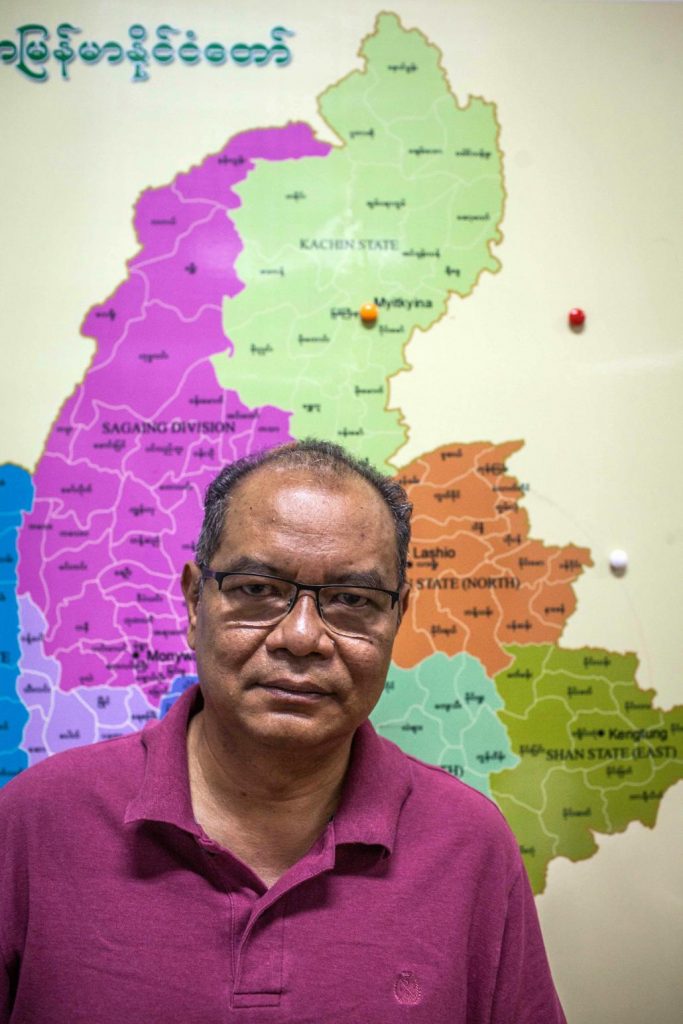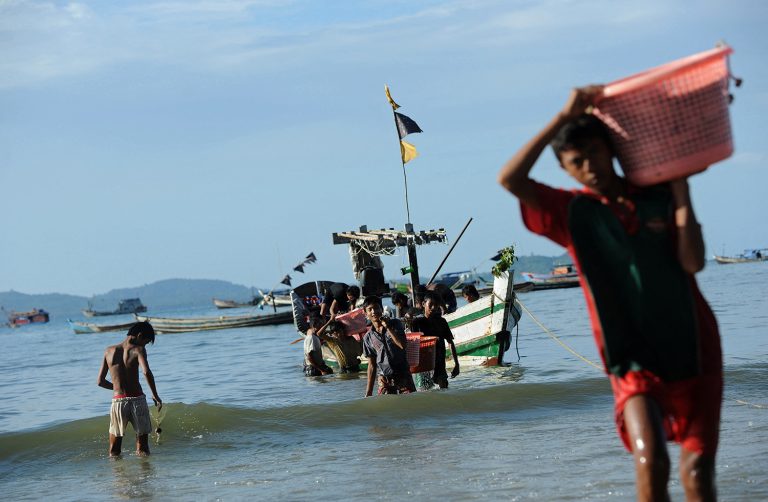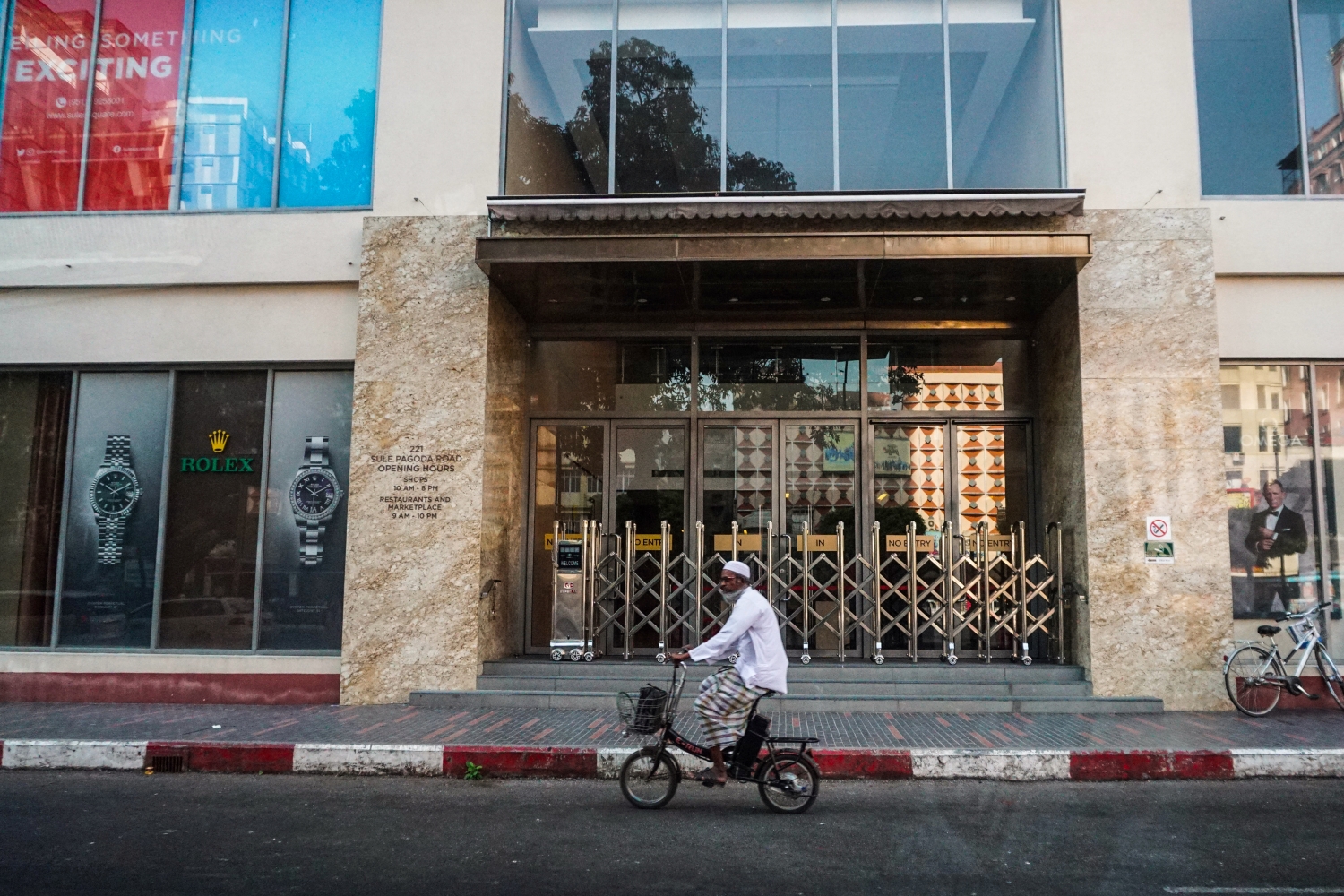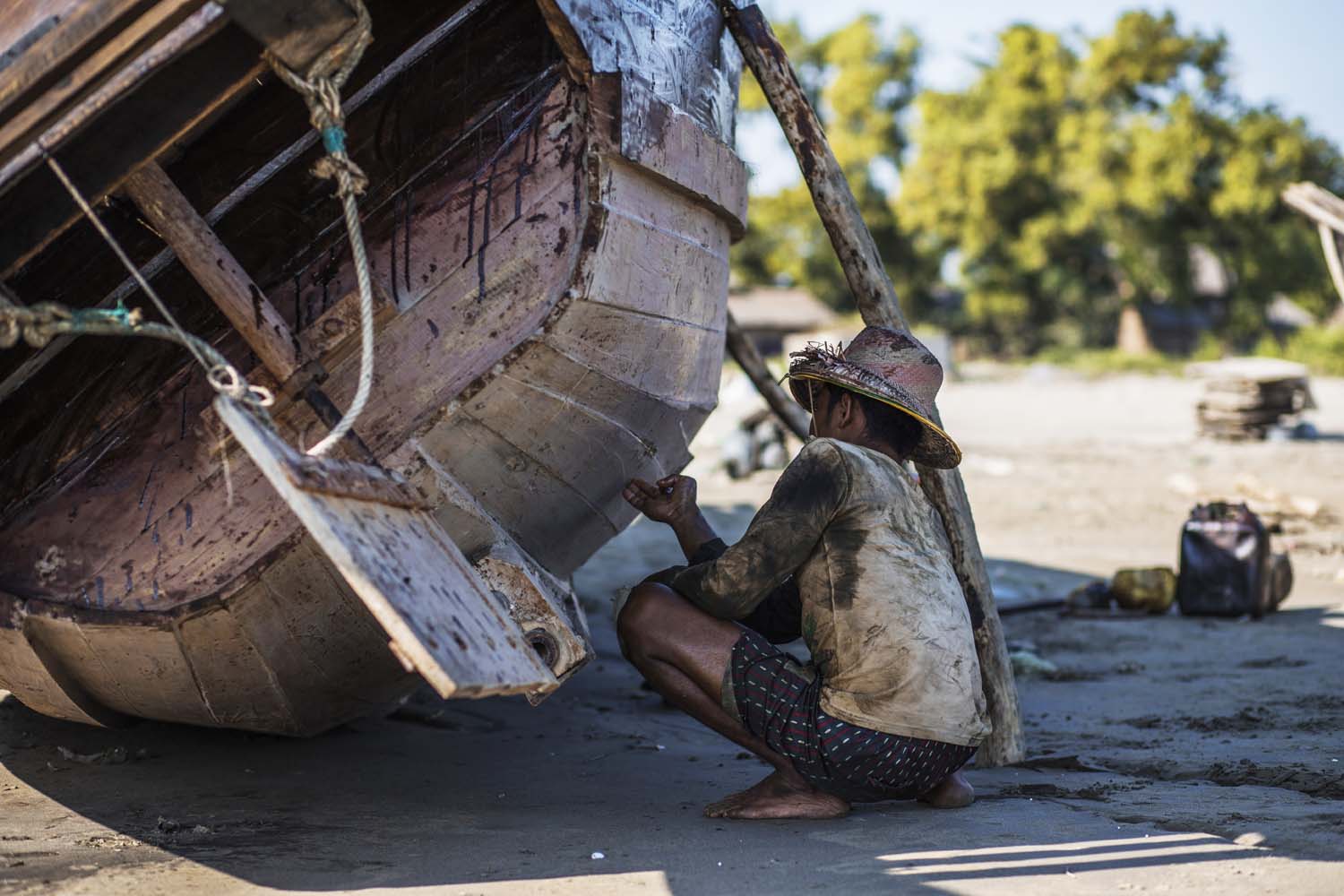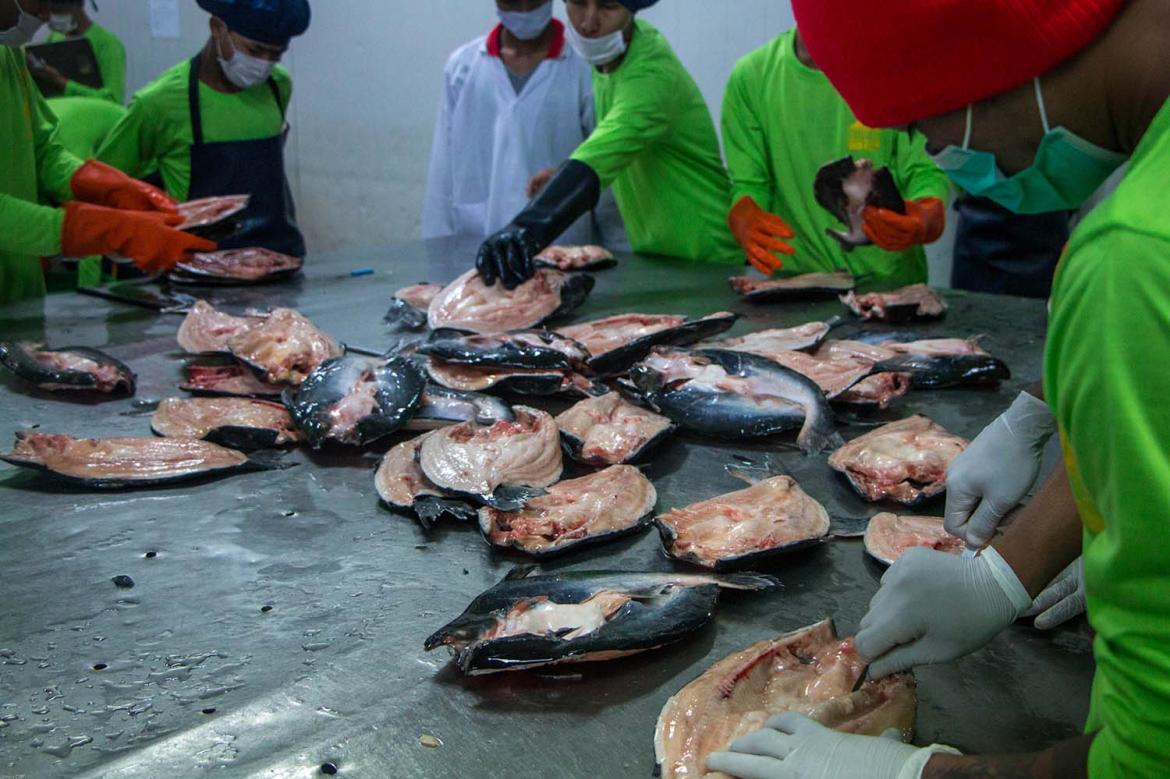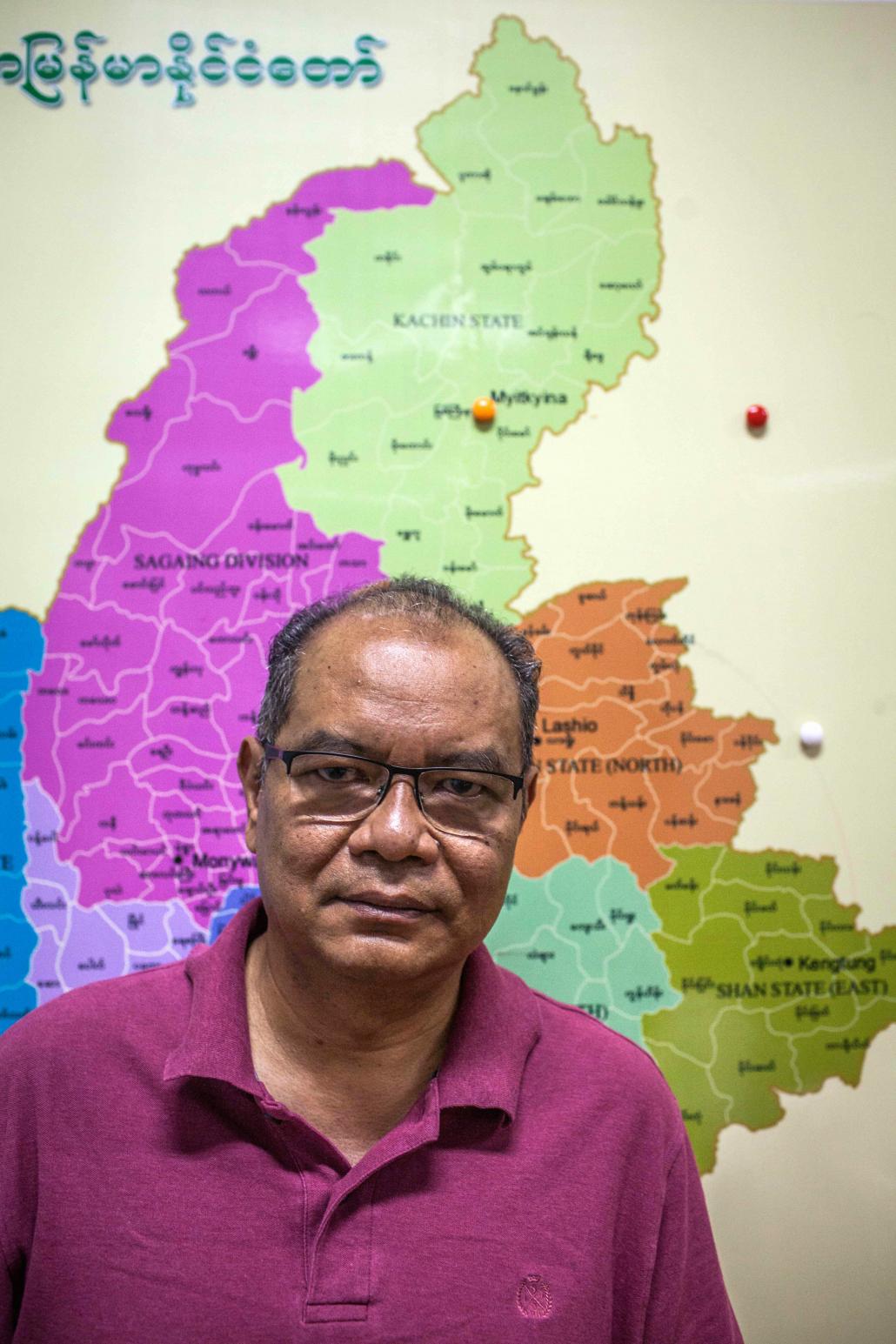
U Tin Maung Thann. (Lauren DeCicca / Frontier)
He is the President of Myanmar Egress, the Vice President of the Myanmar Fisheries Federation, and a former member of the National Economic Advisor Council, that advises the Government on economic policy. But U Tin Maung Thann is probably best known for being one of the driving forces behind the Myanmar Peace Center, an organization setup to facilitate and mediate in the peace process. As a member of the Union Political Dialogue Joint Committee U Tin Maung Thann will sit at the negotiation table when the peace process enters the political dialogue phase next month. Frontier discussed issues ranging from inclusiveness to the NLD government and the soon to be operational joint peace fund.
Let’s start with the nationwide ceasefire, that has been signed two months ago. Some say 8 signatories out of 16 participating ethnic armed organizations in the peace talks is not a resounding success.
Well, eight groups doesn’t mean it’s half. We silenced the guns in two thirds of the conflict areas. By strength of forces of the 8 signatories, it’s like 80 per cent of the ethnic armed forces.
What motivates the non-signatories? Is it because the States bordering on China are rich on resources and they have more to gain economically from the current status quo?
The groups down south also have resources, but they border with Thailand. The Thai are neutral and very supportive. That decomplicates the political decisions along the Thai border. It’s a different story in the States that border with China. Political Chinese influence is not that significant, but vested personal business interests on both sides of the border are. That is the non political part of the factors affecting decision making.
Psychological factors play a role as well. At the very leadership level of for example the KNPP or the NMSP the leaders are old, their worldviews are very limited, and it’s a struggle to get them to come forward and sign. Psychologically they’re not secure. So we have to give them time. Or the changing political situation could influence the dynamic.
How can you persuade the non-signatories to sign?
Support more independent journalism like this. Sign up to be a Frontier member.
We should not oversimplify the problem. There is no easy solution. If you look at the dynamics within the groups, some of the leadership, especially the younger generation, wants to sign. They see the huge political benefits. But the old conservative hardliners are less eager. There’s mixed feelings in the organizations.
According to my four years experience with them time is the only medicine. They need time. How long? Nobody knows. One thing is sure: political development on the mainland side will have a positive effect. If the country opens up further and the economy develops that will be helpful for the peace process.
Throughout the process the one key factor, the success of this process has been the patience, tolerance and the understanding on the government and Tatmadaw side. Especially our chief negotiator U aung Min. He is really dedicated to build understanding and trust, to bring all of them together.
Mid January the next step in the peace process will be taken with the start of the political dialogue phase. What will be on the agenda in January?
They are finalizing the framework as we speak. There are three major camps: the ethnic armed groups, government, Tatmadaw and Hluttaw, and the political parties. National League for Democracy representatives will participate in the talks.
We have to be creative. On the one hand we need to stick to what we agreed in the NCA. That’s one condition. The second condition is that the next government should be in the driver’s seat to take critical decisions. That’s why we proposed that there will be only a few critical things on the agenda. Participation is one subject. All armed ethnic organizations will be involved, but we will categorise. The ones who signed will have a full say. Those who didn’t sign can join as observers. We have urged the ethnic armed organizations to form a coordinating committee for signatories and the non-signatories.
The participation part is not a problem anymore. They are struggling with representation, the number of the delegates and the ratios. That is going to be in the political dialogue framework, the first agenda item.
Agenda item number two will be to formulate the guiding principles, because this going to be a long process. I wouldn’t call it a national convention but 500, 700 or 1,000 delegates will have to go through this long process to reach a political settlement for all the political forces in this country. For that reason the guiding principle part is very important.
The third item on the agenda will be the structure of the national dialogue, let’s not call it a national convention. We don’t plan to settle this in the first session. We will combine all the proposals on structure in a package, that will be discussed at the second session. The first session will take maximum ten days. Our responsibility is to complete the first session and pave the way for the new government to come in. We don’t want any hiccups.
What will the long term timeframe be for the national dialogue?
That will be discussed in the second session, when they start the real stuff. If you look at this as a house, we want to lay the foundations. The future government will build the structure. And the third government might take care of the interior. How long it all will take? My educated guess is that it will take at least 5 years before the people can feel and see the new house. But they can’t yet move into the new house.
In the first 5 years we can reach fundamental agreements on issues like federalism, self determination and cultural rights. In the ten years after that we will finetune everything. We’re remodeling the whole society. That will take time. But it’s a good start.
Federalism is a key issue. But it seems people have a different interpretation of what federalism means.
Let me start with my own experience with discussing federalism with the ethnics. We talk, talk, talk. But at the end the only thing that is important to them is: ‘you treat me well’. What I found out is that we have very big issue, but the solutions are very simple and fundamental.
And I think we are going in the right direction.
We don’t know yet which federal design is going to be useable for Myanmar. If you ask me as someone who has a bit of background in this, I would imagine that the seven States can become federal States, based on their ethnic identities. And the seven regions can be based on their geographical diversity. That kind of hybrid model can be workable for us.
Some of the ethnic provinces have a lot of resources. That might be one of the reasons the Bamar have tried to dominate these areas. How do you view resource sharing?
Let me clarify one thing first: there is no Bamar at all. It is very difficult to identify as Bamar, even in my family. In my family I am the only pure Bamar. I married to a Shan and I have three kids. So I am a minority in my own family. Myanmar is a melting pot. If we look at our DNA I think it would be difficult to find a pure Bamar.
The root causes of our problems can be found in colonial times. The majority was well developed, and the minorities were isolated and underdeveloped. That is the conflict actually, it is not a fight between ethnicities.
How can we find solutions? We can start with the structural design of the federal state. If we can come up with a hybrid structure, we can negotiate how to share the resources and the power.
Take for example Kachin State. People are talking about jade and logging, but actually when Kachin State is peaceful things will change. What I understand is that there is a USD 230 billion deposit of iron ore hidden in Kachin soil. The Chinese market is sitting next to that. Compared to that jade is peanuts. With the current day level of stability that iron ore extraction cannot be done. We need real peace first. We need a very good political statement to have sustainable development in this country for the future generations.
There is going to be a new government, and it is going to be led by the National League for Democracy. What is your assessment of Daw Aung San Suu Kyi, peace and her relations with the ethnics?
We already had a few discussions with her. I am not in the position to disclose details, because this is a delicate matter for the transition. Even Daw Aung San Suu Kyi is keeping very quiet on this. What I can tell you, is that she in principle recognizes the importance of the peace process. If you ask me about her position, it is positive. All the leaders – U Thein Sein, Senior General Min Aung Hlaing, and Daw Aung San Suu Kyi – realize the importance of peace for our society. So whenever they meet they discuss this core issue.
What does the future hold for the Myanmar Peace Center under the new government?
We are waiting and we are negotiating. Structure is not an issue for us. We are doing this not for one party, or one group in society. The longterm process will be there. Whatever adjustments we need to make, we are prepared to make. If there is going to be an MPC under a NLD government? We don’t know yet, we’re talking.
With whom are you negotiating? The donors?
The donors I really don’t care about. I know the game. We recognize the donors’ role in the peace process. One reason why the peace process is a success, is because we know how to put them were, and what their real role is. The donors have their obligations and their interests, and we can balance that. This will be a new chapter for the donors to deal with all the issues here. In some areas they will have more access, or more influence. In some other areas they will have the tone down a lot.
A group of donor countries led by the EU have announced that they will form a joint peace fund, to support the peace process. What are your thoughts on this?
No comment on that one. I have been directly involved, so my comments can influence the process. In general, there are pros and cons. We are looking into this very thoroughly. Technically it is not a big deal. We facilitated LIFT when Myanmar was more closed off, this was the first of the multi trust style funds here. It can be done. But the political landscape will be more open, so I don’t want to limit myself to this joint peace fund. This is what we have to settle in the negotiations.
Are you happy with how the peace process is unfolding?
The things we have achieved are unprecedented. After the Panglong agreement the NCA is the one and only document that all the political forces can agree with. The process was even more important. We worked two years on that and built a lot of trust and understanding. That is the real value. This document is different from the others as well. This is not a government proposal. This is a coordinated proposal by all the ethnic armed groups. Happy is not a big enough word to express my feelings.


